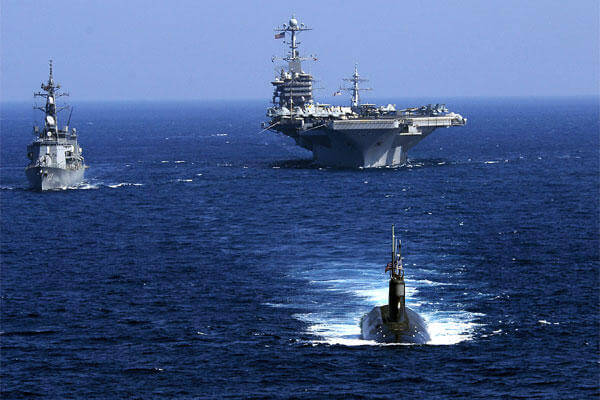Budget shortfalls and the Navy's planned pace of adding new ships, compared to those retiring, will likely amount to a future where the service will not achieve its goal of a 306-ship fleet anytime soon unless substantial changes are made, analysts and lawmakers say
A close look at the Navy's shipbuilding plan shows the service will decommission more ships in the next five years than it will commission. This is happening, in part, because some of the many ships added during the Reagan build-up, such as the Los Angeles-class submarines and Aegis cruisers, are now beginning to retire.
During the Regan years, the Navy grew to more than 500 ships, nearly double the services' current 285-ship fleet.
The Navy's long-term fleet plan, as articulated in its 30-year shipbuilding plan, calls for a 306-ship Navy fleet broken down as follows: 12 fleet ballistic missile submarines, 11 nuclear-powered aircraft carriers, 48 nuclear-powered attack submarines, 88 large, multi-mission surface combatants and 52 small, multi-role surface combatants.
"Our current shipbuilding plan balances anticipated future demands for naval forces with expected resources. The goal is to work within fiscal limitations to meet these core mission responsibilities with needed capacity," said Lt. Caroline Hutcheson, Navy spokeswoman.
However, Navy officials said that while no formal new assessment of fleet size is underway, the service is always considering strategic questions in light of growing threats.
"The fleet is not big enough. The Navy routinely does not meet the combatant commanders' requirements worldwide. The amount of time that ships spend away from home is increasing as the fleet size levels out and the demands on the fleet increase," said Bryan McGrath, retired Navy officer who is now a managing director at FerryBridge LLC, a defense consulting firm based in Easton, Md.
Meanwhile, the prospect of continued sequestration is adding to the difficulties regarding available funds for shipbuilding, Navy officials said. In fact, substantial impacts to the service's shipbuilding plan are expected if sequestration continues into fiscal year 2014.
The Seapower and Projection Forces Subcommittee has asked the Navy to provide a report by March 1, 2014, that is based on a budget of $16 billion annually across the entire 30-year shipbuilding plan.
Rep. Randy J. Forbes, Chairman of the House Armed Services Seapower and Projection Forces Subcommittee, have expressed concern that that the eventual fleet size may wind up being closer to 250 ships, unless specific measures are taken to address budget shortfalls.
Navy officials said that the total inventory of battle force ships and numbers of each type of ship will vary from year-to-year as a result of the complex relationship between retirements, procurement, design and construction times, as well as funding availability, industrial base capacity, and war-fighting priorities.
"We remaining committed to our goal of 306 ships, we submit our budget based on our requirements," Hutcheson said. "We dip down as some of the legacy ships retire until we build back up."
The shipbuilding plan states that it expects to spend an average of $16.8 billion per year on new ship construction.
However, the addition of ships does not keep pace with the number of ships which are decommissioning, lowering the fleet size until much later in the 30-year plan, analysts and lawmakers emphasize.
"They are taking ships out of the fleet and most of the build out does not come until the end of that 30-year period -- so the only time you reach that 306-ship fleet is 30-years from now,"Forbes said in an interview with Military.com.
"The reality is our combatant commanders around the globe are the gold standard regarding threats when it comes to requirements and seeing what we need. I think we should have a Navy that meets at least 90-percent of those validated requirements."
Forbes explained that the Navy was able to meet 90-percent of the combatant commander's requirements in 2007, a number which wound up dropping to roughly 51-percent by 2012.
Forbes, who has authored several op-eds recently about the growing importance of seapower and force projection in coming decades, is concerned that there may be a budget shortfall when it comes to allocating funds needed for shipbuilding.
"The last ten years have been the decade of the Army and the Marine Corps. We've asked them for disproportionate sacrifices -- but the next two decades, almost every analyst recognizes, is going to be the decade of the Navy. We can't afford to get this wrong," Forbes explained.
Forbes said he does not want budget circumstances or acquisition plans to drive strategy. Instead, he argues that strategy itself should drive both budget and acquisition decisions.
"That takes a lot of discipline," he emphasized.
The build up toward the end of the 30-year plan will, at least in large part, be due to the addition of Littoral Combat Ships, service officials said.
In 2010, an independent panel of experts examined the 2009 Quadrennial Defense Review and told the Senate Armed Services Committee that, given the range of anticipated threats, a 346-ship Navy was their recommendation.
"We think the challenge is going to get greater, and we don't see how you can meet a greater challenge with a diminishing number of ships," Steven Hadley, co-chair of the QDR review independent panel, told the committee in 2010.


























